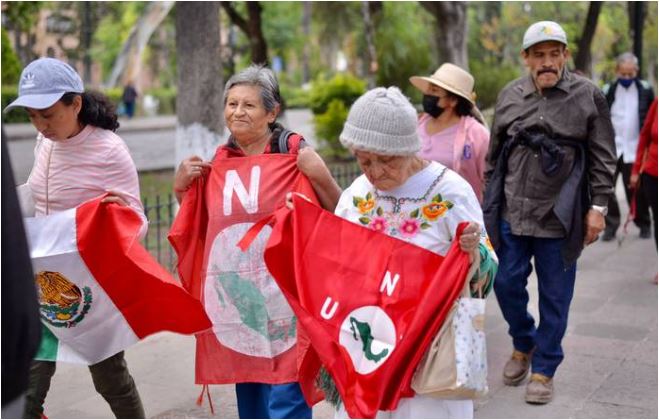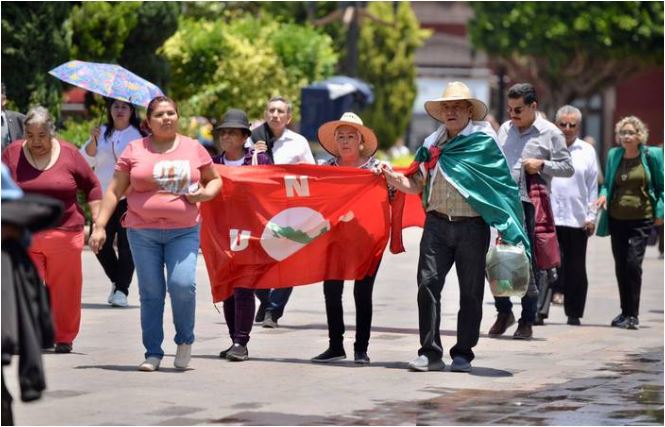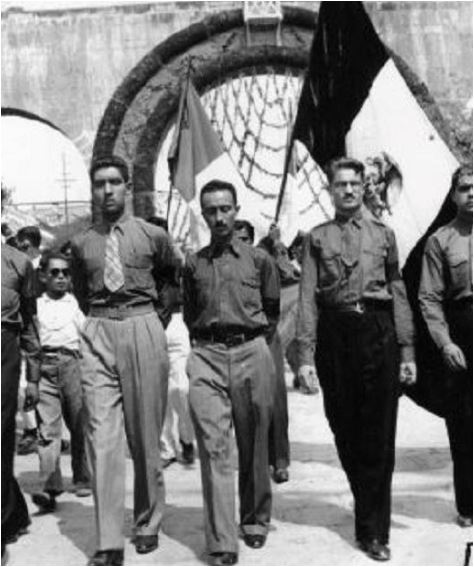The Little-Known History of the Synarchist
Introduction
The National Synarchist Union, better known as Unión Nacional Sinarquista (UNS), is a fascinating chapter in Mexican history that’s rich with ideological fervor, political maneuvering, and a deep-rooted Catholic faith. The early 20th century was a time of growing American influence in Latin America, often perceived as imperialistic and exploitative. This backdrop fueled anti-Yankee sentiments among many Mexicans, who saw the United States as a threat to their sovereignty and cultural identity.
Synarchism positioned itself as a defender of Hispanic and Catholic values against the encroaching influence of American liberalism and materialism. The movement’s literature often featured strong anti-Yankee rhetoric, portraying the United States as a cultural and political adversary.
The ideology of Synarchism sought to establish a new social order within Mexico that would position the country at the forefront of the Ibero-American countries. Under this new order, Mexico would become the standard-bearer in defense of the Hispanic spiritual content against foreign powers. This, in turn, gave rise to the notion that the country had a special destiny as a nation destined to achieve a historical mission in the universal concert, Hispano-Americanism, and evangelization.
The Catholic Roots of the UNS

The UNS was deeply embedded in Roman Catholicism from its inception. Its founders were fervent Catholics who sought to counter what they perceived as the anti-religious policies of the PRI and its predecessors. This religious fervor set the stage for a movement that was as much about preserving Catholic values as it was about political power.
Ideological Foundations
The ideological foundation of the UNS was built on the principles of social justice, Catholic doctrine, and a rejection of Marxism. The movement’s leaders believed that Mexico should return to its Catholic roots, which they felt were being eroded by the secular policies of the ruling party.
Support from the Clergy
The UNS received substantial support from the Catholic clergy, who saw the movement as a bulwark against the anti-clerical sentiment that had permeated Mexican politics. Priests often used their pulpits to promote the UNS, framing it as a divine mission to save Mexico from moral decay.
Grassroots Mobilization
One of the most effective strategies employed by the UNS was grassroots mobilization. They organized local committees, held community meetings, and even ran educational programs to spread their message. This grassroots approach helped them build a robust network of supporters across the country.
The Connection Between The Cristero Wars
The Cristero War and the rise of Synarchism in Mexico are closely connected through their shared roots in opposition to the secularizing policies of the Mexican government and their defense of Catholic values.
The Cristero War (1926-1929)
- Background:
- The Cristero War was a reaction to the anti-clerical policies of President Plutarco Elías Calles and the enforcement of the 1917 Mexican Constitution, which severely restricted the influence and activities of the Catholic Church.
- These policies included closing religious schools, banning religious orders, and limiting the number of priests.
- Conflict:
- In response, devout Catholics, including many peasants, clergy, and laypeople, took up arms against the government. This conflict, known as the Cristero War, saw brutal fighting and significant loss of life on both sides.
- The Cristeros, as the rebels were called, fought under the slogan “¡Viva Cristo Rey!” (Long live Christ the King).
- Outcome:
- The war ended with negotiations and some concessions to the Church, but the anti-clerical laws remained officially in place, even if they were less stringently enforced.
- The conflict left a deep impact on Mexican society, fostering a strong sense of Catholic identity and resistance among many Mexicans.
Rise of Synarchism in the 1930s
- Origins:
- In the 1930s, the National Synarchist Union (Unión Nacional Sinarquista, UNS) emerged, drawing on the sentiments and social networks that had been activated during the Cristero War.
- The movement was founded in 1937 and formally established in 1939, advocating for a new social order based on Catholic social teaching and opposition to secularism, communism, and liberal democracy.
- Ideology:
- Synarchism sought to create a corporatist state with a strong emphasis on Catholic values, social hierarchy, and communal solidarity.
- The movement emphasized anti-Yankee Hispanism, positioning itself against American influence and promoting Hispanic cultural and spiritual values.
- It was also against the ruling elites and what it saw as their neglect of traditional Mexican and Catholic values.
- Membership and Influence:
- The UNS attracted many former Cristeros and their supporters, as well as other conservative elements in Mexican society who felt alienated by the government’s policies.
- It gained substantial support in rural areas and among the lower middle class, particularly those who had suffered from the government’s secular and agrarian reforms.
- Political Activity:
- Although Synarchism never gained direct political power, it influenced Mexican politics by representing a significant conservative and Catholic constituency.
- The movement’s ideas and rhetoric continued to resonate in Mexican society, contributing to the ongoing tension between secular and religious forces in the country.
The Cristero War was a catalyst for the rise of Synarchism in Mexico
The Cristero War and the rise of Synarchism are connected in several ways:
- Shared Roots: Both movements emerged from a context of opposition to the secularization policies of the Mexican government and the perceived attack on Catholic values and institutions.
- Common Support Base: Many former Cristero fighters and sympathizers found a new political home in the Synarchist movement, which promised to continue the fight for a Catholic social order.
- Ideological Continuity: Synarchism carried forward the Cristeros’ vision of a society governed by Catholic principles, positioning itself as the defender of the faith and traditional values against secularism and foreign influences.
- Historical Legacy: The Cristero War left a legacy of militant Catholicism and anti-government sentiment that Synarchism tapped into, shaping its ideology and expanding its support base.
In summary, the Cristero War laid the groundwork for the rise of Synarchism by fostering a militant Catholic identity and a strong opposition to secularization, which the Synarchist movement harnessed and continued to promote in the following decades.
The UNS was officially founded in 1937, at a time when Mexico was undergoing significant political and social changes. The movement quickly gained traction, attracting thousands of members eager to fight for a Catholic Mexico.
Initial Struggles
In its early years, the UNS faced numerous challenges, including government opposition and internal disagreements. However, their unwavering commitment to their cause helped them overcome these obstacles and continue to grow.
Nationwide Support
By 1940, the UNS had amassed over 500,000 registered members, making it one of the largest political movements in Mexico. Their ability to mobilize such a large base of support was a testament to their effective organizational strategies and the resonance of their message.
Political Campaigns
The UNS didn’t just focus on grassroots activities; they also participated in political campaigns to gain formal power. Although they faced significant opposition from the PRI, their electoral efforts helped them gain visibility and legitimacy.
Opposition to the Institutional Revolutionary Party (PRI)
The UNS’s primary political adversary was the PRI, which had dominated Mexican politics for decades. The UNS vehemently opposed the PRI’s secular policies and sought to challenge its hegemony.
Anti-Communist Stance
One of the key points of contention between the UNS and the PRI was the issue of communism. The UNS was staunchly anti-communist, viewing Marxist ideology as incompatible with Catholic values. This opposition resonated with many Mexicans who were wary of communist influences.
Clashes with Government Forces
The UNS’s activities often brought them into direct conflict with government forces. Protests and rallies organized by the UNS were frequently met with repression, leading to arrests and violent confrontations. These clashes only served to galvanize their supporters.
Media Influence
Despite facing censorship and propaganda from the government, the UNS managed to maintain a presence in the media. They published newsletters and pamphlets to spread their message and counter government narratives.
The Controversial Support for Axis Powers
One of the most contentious aspects of the UNS’s history was their support for the Axis Powers during World War II. This stance significantly tarnished their reputation and led to internal strife.
Ideological Alignment
The UNS’s support for the Axis Powers stemmed from their ideological alignment with some of the fascist elements in Europe. They admired the authoritarian and nationalist aspects of these regimes, which they believed could be models for Mexico.
Public Backlash
The UNS’s pro-Axis stance led to a significant public backlash. Many Mexicans were appalled by their support for regimes that were responsible for widespread atrocities. This backlash eroded much of the support the UNS had built over the years.
Internal Division
The controversy over the Axis Powers caused deep divisions within the UNS. Leaders and members who disagreed with this stance began to splinter off, leading to infighting and weakening the organization’s cohesion.
The Decline and Demise of the UNS
The UNS’s decline was marked by internal conflicts, diminishing support, and strategic missteps. By 1951, the movement had all but disintegrated as a political force.
Leadership Struggles
The infighting that plagued the UNS was exacerbated by leadership struggles. Key figures within the movement vied for control, leading to further fragmentation and a loss of direction.
Waning Public Interest
As the political landscape in Mexico evolved, public interest in the UNS waned. New movements and parties emerged, offering alternatives to both the PRI and the UNS, drawing away potential supporters.
Formal Disbandment
In 1951, the UNS formally disbanded as a political party. While some remnants of the organization persisted in certain localities, its influence on the national stage was effectively over.
The Legacy of the UNS in Guanajuato
Despite its fall from national prominence, the UNS managed to retain some local influence, particularly in the city of Guanajuato. The legacy of the UNS can still be felt in this region today.
Cultural Impact
In Guanajuato, the UNS’s emphasis on Catholic values has left a lasting cultural impact. The city’s residents continue to uphold many of the traditions and beliefs championed by the UNS.
Local Politics
The UNS’s influence is also evident in local politics. Several local leaders and politicians trace their political lineage back to the UNS, and its ideologies continue to shape local governance.
Historical Memory
The UNS is remembered in Guanajuato through various monuments, museums, and historical sites. These serve as reminders of the movement’s impact and its complex legacy.
The UNS’s Place in Mexican History
The story of the UNS is a compelling chapter in Mexican history, offering valuable insights into the country’s political and social dynamics. It serves as a case study in how religious fervor and political ambition can intersect to create lasting change.
Lessons for Modern Movements
Modern political movements can learn several lessons from the UNS’s successes and failures. The importance of grassroots mobilization, the risks of controversial stances, and the need for cohesive leadership are all critical takeaways.
Historical Significance
The UNS’s opposition to the PRI and its role in Mexican politics provide important context for understanding the broader historical landscape of the 20th century in Mexico.
Continuing Relevance

Even though the UNS is not as active, its legacy continues to be relevant in discussions about religion, politics, and social movements in Mexico. It serves as a reminder of the powerful role that ideology and belief can play in shaping a nation’s history.
Conclusion
The rise and fall of the National Synarchist Union is a testament to the complex interplay of faith, politics, and ideology. From its Catholic roots to its nationwide influence and eventual decline, the UNS offers a rich tapestry of lessons and insights. For history buffs and political enthusiasts, exploring the story of the UNS is an opportunity to understand a unique and impactful movement in Mexican history.
If you found this post intriguing and want to learn more about other fascinating political movements, feel free to explore our other articles or get in touch with our team of historians and political analysts. Happy reading!

